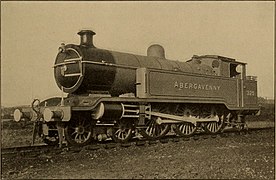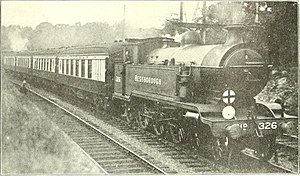| LB&SCR J1 and J2 classes | |||||||||||||||||||||||||
|---|---|---|---|---|---|---|---|---|---|---|---|---|---|---|---|---|---|---|---|---|---|---|---|---|---|
 J1 class 'Abergavenny' J1 class 'Abergavenny' | |||||||||||||||||||||||||
| |||||||||||||||||||||||||
| |||||||||||||||||||||||||
| |||||||||||||||||||||||||
| |||||||||||||||||||||||||
The LB&SCR J1 and J2 classes were 4-6-2 steam tank locomotives designed by D. E. Marsh for express passenger services on the London, Brighton and South Coast Railway.
History
Following the success of his I3 4-4-2 tank locomotive class, Douglas Earle Marsh decided to enlarge the class to create a tank locomotive capable of hauling the heaviest London-Brighton express trains. The first locomotive No. 325 was classified "J1" and completed by Brighton Works in December 1910. It incorporated a Schmidt superheater and inside Stephenson valve gear. After initial modifications to the firebox to improve its coal consumption, it proved to be a successful design. A second locomotive was therefore ordered in May 1911, but Marsh soon afterwards went on prolonged sick leave and all work ceased.
Marsh's successor Lawson Billinton made detailed changes to the design before work on the second locomotive recommenced, incorporating the Walschaerts valve gear. No. 326 was therefore classified as "J2" and completed in March 1912.
Both locomotives performed well, although No. 326 was considered the faster. They were used on the heaviest trains, together with the H1 and H2 classes until after the formation of Southern Railway in January 1923.
During 1925 and 1926, the two classes were gradually replaced on the heaviest London-Brighton express trains by the "King Arthur" and "River" classes, and were used on lighter express services until the electrification of the London to Brighton line in 1935. Thereafter they were transferred to Eastbourne and used on London expresses from that town until they ceased following the outbreak of the Second World War.
The two locomotives spent the early months of the War in store but were later transferred to Tunbridge Wells. They both survived into British Railways (BR) ownership in 1948, but in June 1951 they were both replaced by new LMS Fairburn designed 2-6-4T locomotives and were withdrawn and scrapped.
Locomotive summary
| LB&SC No. | Name | Built | SR No. | B.R. No. | Withdrawal |
|---|---|---|---|---|---|
| 325 | Abergavenny | December 1910 | 2325 | 32325 | June 1951 |
| 326 | Bessborough | March 1912 | 2326 | 32326 | June 1951 |
References
- Bradley, (1974) p.119
Sources
- Bradley, D.L. (1974). Locomotives of the London Brighton and South Coast Railway: Part 3. Railway Correspondence and Travel Society.
External links
| London, Brighton and South Coast Railway locomotives | |
|---|---|
| London and Brighton Railway (1841-1846) | |
| J. C. Craven (1847–1869) | |
| W. Stroudley (1870–1889) | |
| R. J. Billinton (1890–1904) | |
| D. E. Marsh (1905–1911) | |
| L. B. Billinton (1911–1922) | |


